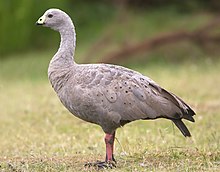Lake Newland Conservation Park: Difference between revisions
m →External links: clean up, removed stub tag using AWB |
Rescuing 1 sources and tagging 0 as dead. #IABot (v1.3) |
||
| Line 54: | Line 54: | ||
===Important bird area=== |
===Important bird area=== |
||
[[File:Cereopsis novaehollandiae 2.jpg|thumb|right|The conservation park is an important area for Cape Barren geese]] |
[[File:Cereopsis novaehollandiae 2.jpg|thumb|right|The conservation park is an important area for Cape Barren geese]] |
||
The full extent of the conservation park is overlapped by an [[Important Bird Area]] (IBA) known as the Lake Newland Important Bird Area. The IBA which is a non-statutory arrangement has been identified by [[BirdLife International]] because it regularly supports over 1% of the world population of [[Cape Barren goose|Cape Barren geese]], as dry-season visitors from their offshore island breeding grounds, and significant numbers of [[fairy tern]]s and [[hooded plover]]s.<ref>{{cite web |
The full extent of the conservation park is overlapped by an [[Important Bird Area]] (IBA) known as the Lake Newland Important Bird Area. The IBA which is a non-statutory arrangement has been identified by [[BirdLife International]] because it regularly supports over 1% of the world population of [[Cape Barren goose|Cape Barren geese]], as dry-season visitors from their offshore island breeding grounds, and significant numbers of [[fairy tern]]s and [[hooded plover]]s.<ref>{{cite web|url=http://www.birdata.com.au/iba.vm |title=IBA: Lake Newland |accessdate=2011-07-29 |work=Birdata |first= |last= |publisher=Birds Australia |date= |deadurl=yes |archiveurl=https://web.archive.org/web/20110706102341/http://www.birdata.com.au/iba.vm |archivedate= 6 July 2011 |df= }}</ref> [[Slender-billed thornbill]]s also occur in the park.<ref name=durant/> |
||
==References== |
==References== |
||
Revision as of 20:12, 10 May 2017
| Lake Newland Conservation Park South Australia | |
|---|---|
| Nearest town or city | Elliston |
| Established | 1 August 1991[1] |
| Area | 88.8 km2 (34.3 sq mi)[1] |
| Managing authorities | Department of Environment, Water and Natural Resources |
| Website | Lake Newland Conservation Park |
| Footnotes | Coordinates[2] |
| See also | Protected areas of South Australia |
Lake Newland Conservation Park is a protected area in the Australian state of South Australia located on the west coast of the Eyre Peninsula about 10 kilometres (6.2 mi) north of the town of Elliston. It was proclaimed in 1991 in order to protect Lake Newland, a hypersaline lake, and an associated wetland complex.
Description
The conservation park is located within the gazetted localities of Elliston, Colton and Talia (from south to north).[3]
It was proclaimed in 1991 with some additional land being added in 1996.[4]
Land within the conservation park has a relatively recent geological history, with Holocene sand-dunes creating a barrier between the Southern Ocean and a depression in the Bridgewater Formation of Pleistocene limestone that is common throughout the western Eyre Peninsula. The dunes continue to encroach on the lake, lagoons and other wetlands in the park which are also fed by freshwater springs in the limestone. Average annual rainfall (recorded at Elliston) is 427 millimetres (16.8 in).[4]
The conservation park is named after the lake which itself was named by Edward John Eyre for his friend and travelling companion Richard Francis Newland.[3][5]
It is classified as an IUCN Category Ia protected area.[2]
Vegetation
The conservation park contains mobile sand dunes and sub-coastal wetlands. The vegetation includes areas of previously cleared land with patches of regenerating drooping sheoak woodland and scattered native shrubs. The lake margins are dominated by salt-tolerant Sarcocornia and Tecticornia species. The coastal shrublands that cover much of the reserve are mainly composed of coastal daisybush, with coast beard-heath, seaberry saltbush, long-pod wattle, coastal umbrella bush and cockies tongues. The foredunes behind the beach contain Spinifex hirsutus grassland as well as coast saltbush and knobby club-rush. Swales are characterised by swamp paperbarks and dryland tea-trees over salt-tolerant shrubs.[4]
Other designations
Important bird area

The full extent of the conservation park is overlapped by an Important Bird Area (IBA) known as the Lake Newland Important Bird Area. The IBA which is a non-statutory arrangement has been identified by BirdLife International because it regularly supports over 1% of the world population of Cape Barren geese, as dry-season visitors from their offshore island breeding grounds, and significant numbers of fairy terns and hooded plovers.[6] Slender-billed thornbills also occur in the park.[4]
References
- ^ a b "Protected Areas Information System - reserve list (as of 25 November 2014)" (PDF). Department of Environment Water and Natural Resources. Retrieved 8 January 2015.
- ^ a b "Terrestrial Protected Areas of South Australia (see 'DETAIL' tab)". CAPAD 2014. Australian Government - Department of the Environment. 6 February 2014. Retrieved 12 May 2015.
- ^ a b "Search result for "Lake Newland Conservation Park" (Record no. SA0038338) with the following layers selected - "Suburbs and Localities" and " Place names (gazetteer)"". Property Location Browser. Government of South Australia. Retrieved 16 November 2016.
- ^ a b c d Durant, M.D. (2009). Lake Newland Conservation Park: Opportunities for Implementation of the WildEyre Conservation Action Plan (PDF). Report to the WildEyre project group. Greening Australia SA.
- ^ "Journal of Expeditions in Central ans Southern Australia". South Australian. Vol. IX, , no. 708. South Australia. 24 February 1846. p. 3. Retrieved 15 November 2016 – via National Library of Australia.
{{cite news}}: CS1 maint: extra punctuation (link) - ^ "IBA: Lake Newland". Birdata. Birds Australia. Archived from the original on 6 July 2011. Retrieved 29 July 2011.
{{cite web}}: Unknown parameter|deadurl=ignored (|url-status=suggested) (help)
